Ielts academic Reading 13
A.D.D. - Missing Out on Learning
Study requires a student's undivided attention. It is impossible to acquire a complex skill or absorb information about a subject in class unless one learns to concentrate without undue stress for long periods of time
.
Students with Attention Deficit Disorder (A.D.D.) are particularly deficient in this respect for reasons which are now known to be microbiological and not behavioral, as was once believed. Of course, being unable to concentrate, and incapable of pleasing the teacher and oneself in the process, quickly leads to despondence and low self-esteem. This will naturally induce behavioral problems. It is estimated that 3 - 5 % of all children suffer from Attention Deficit Disorder. There are three main types of Attention Deficit Disorder: A.D.D. without Hyperactivity, A.D.D. with Hyperactivity (A.D.H.D.), and Undifferentiated A.D.D.
The characteristics of a person with A.D.D. are as follows:
• has difficulty paying attention
• does not appear to listen
• is unable to carry out given instructions
• avoids or dislikes tasks which require sustained mental effort
• has difficulty with organization
• is easily distracted
• often loses things
• is forgetful in daily activities
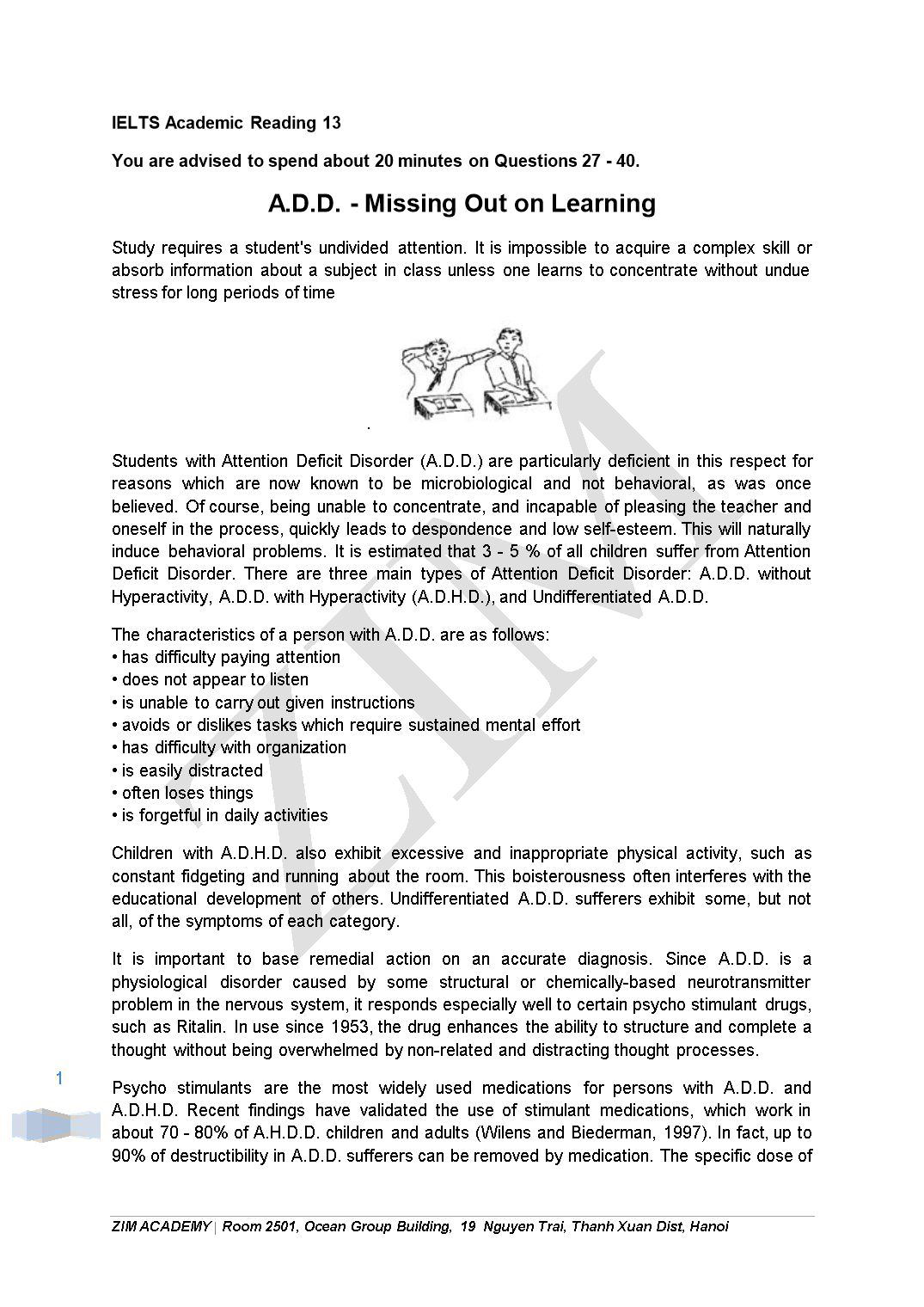
Trang 1
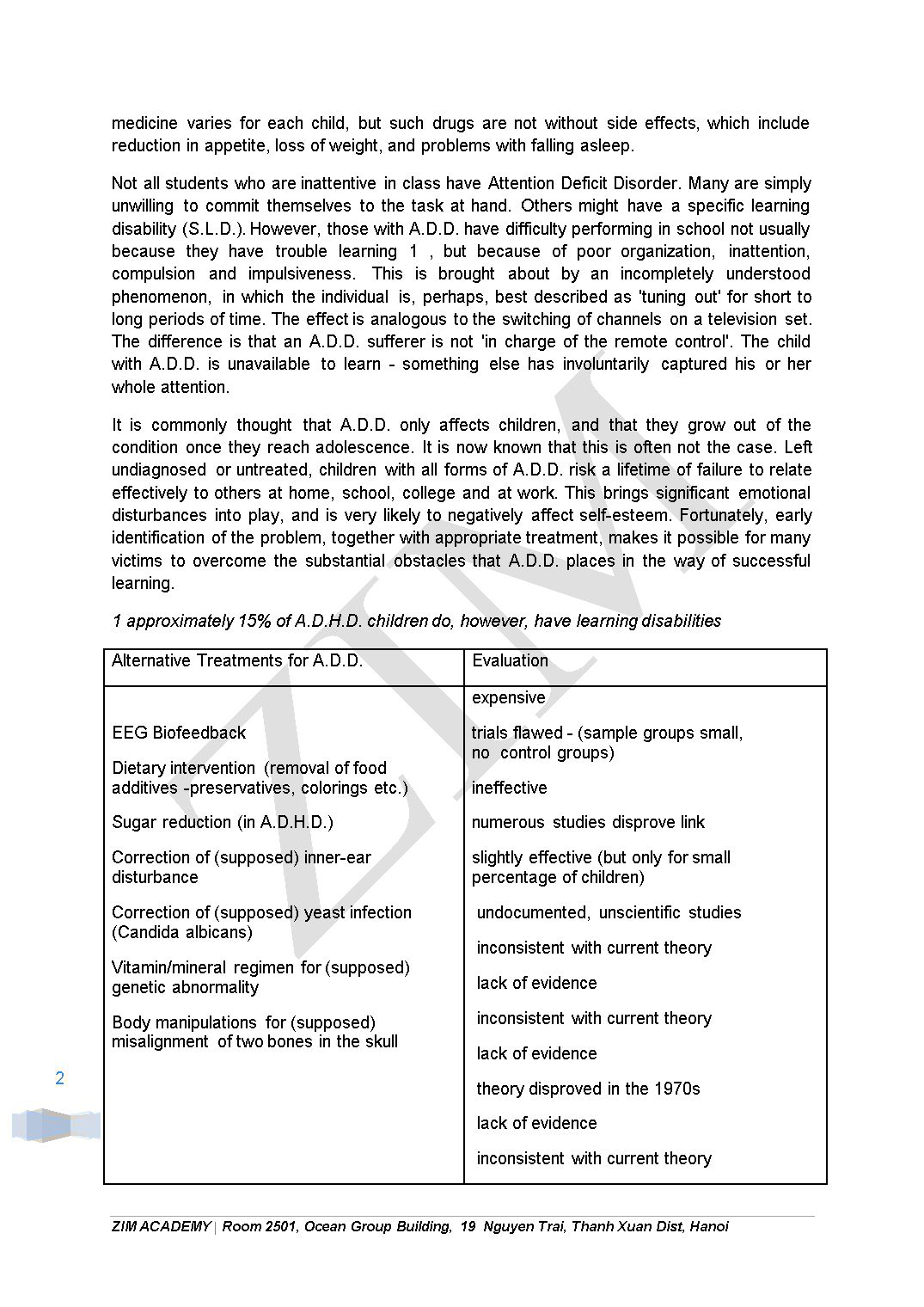
Trang 2
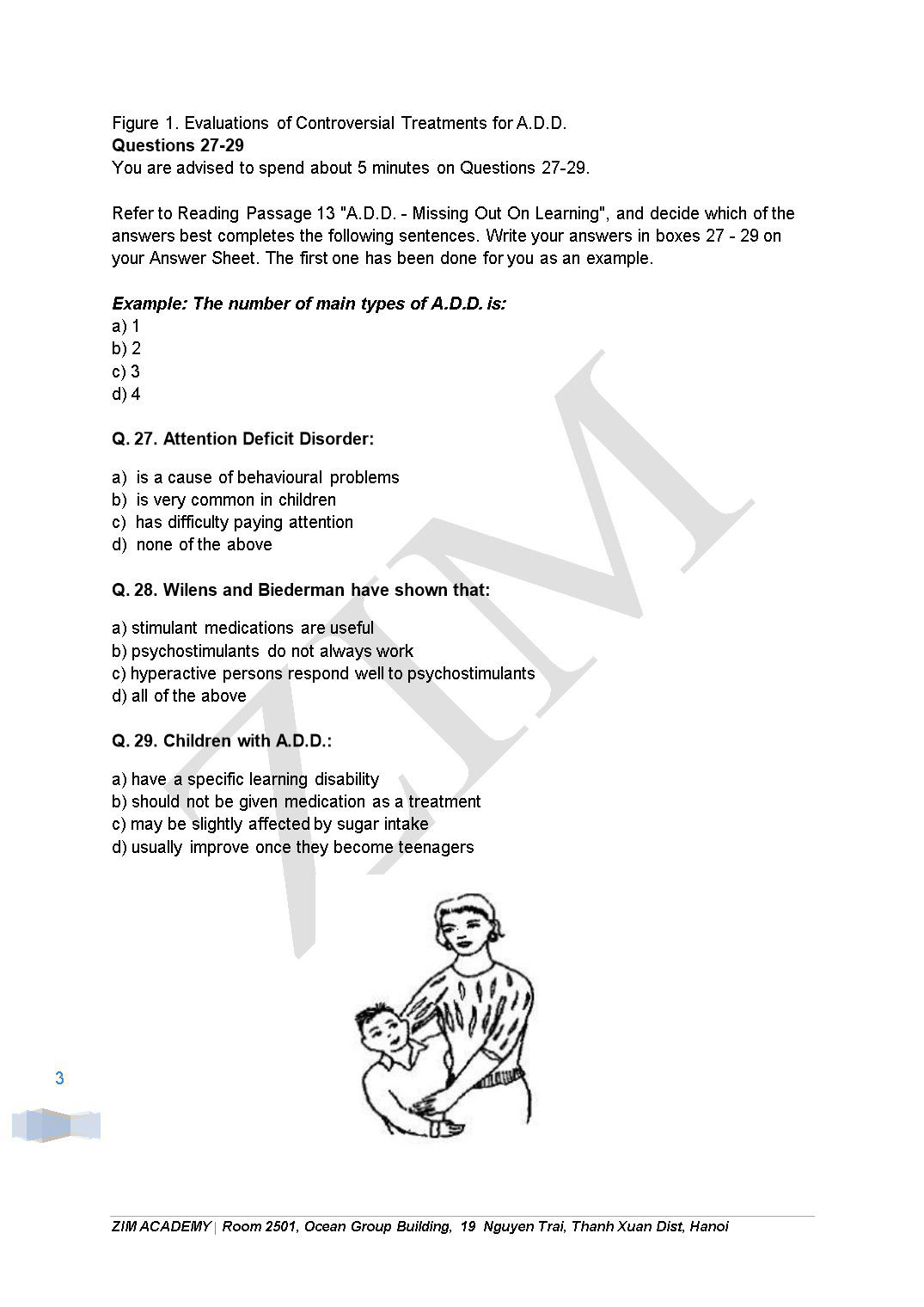
Trang 3
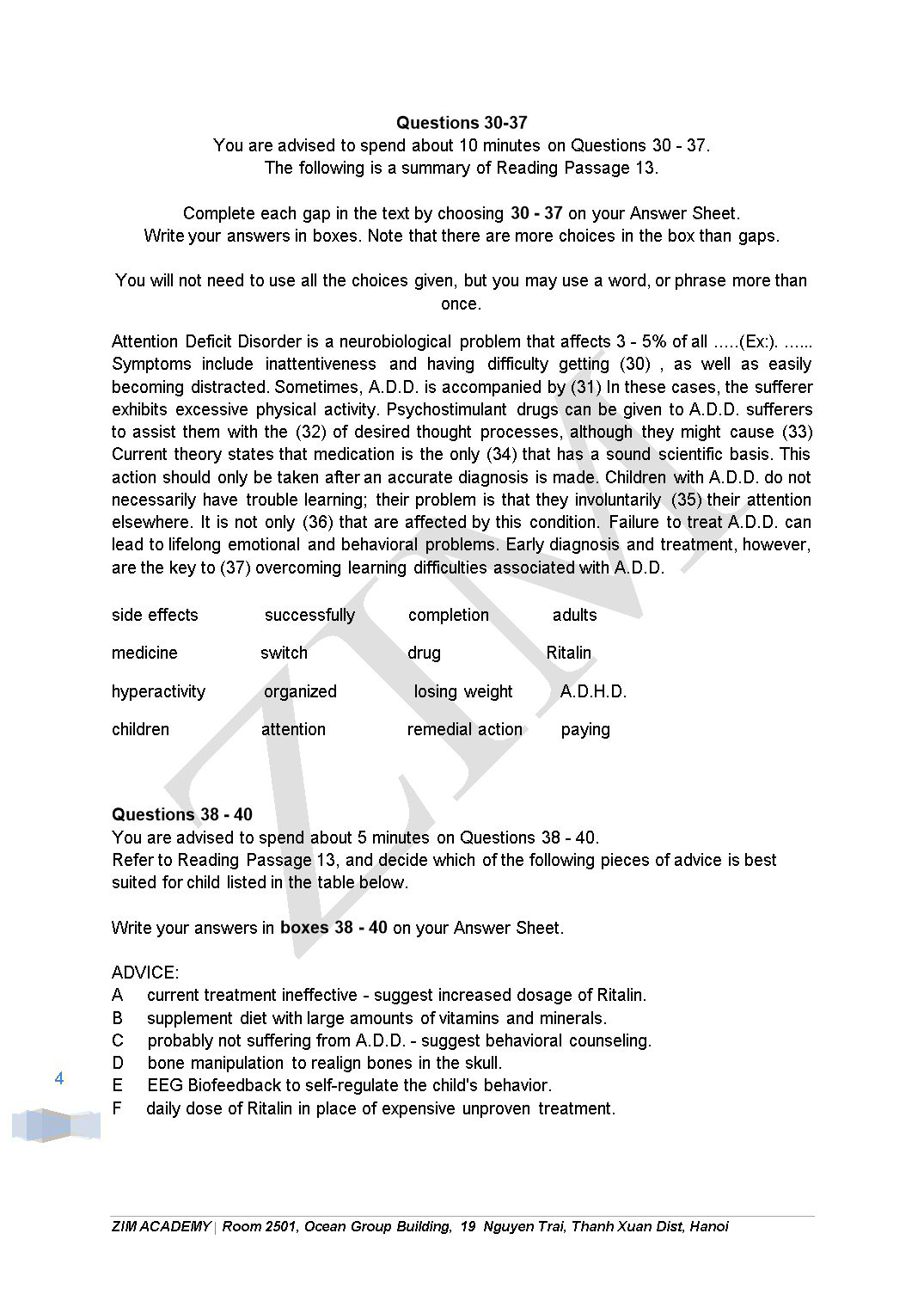
Trang 4
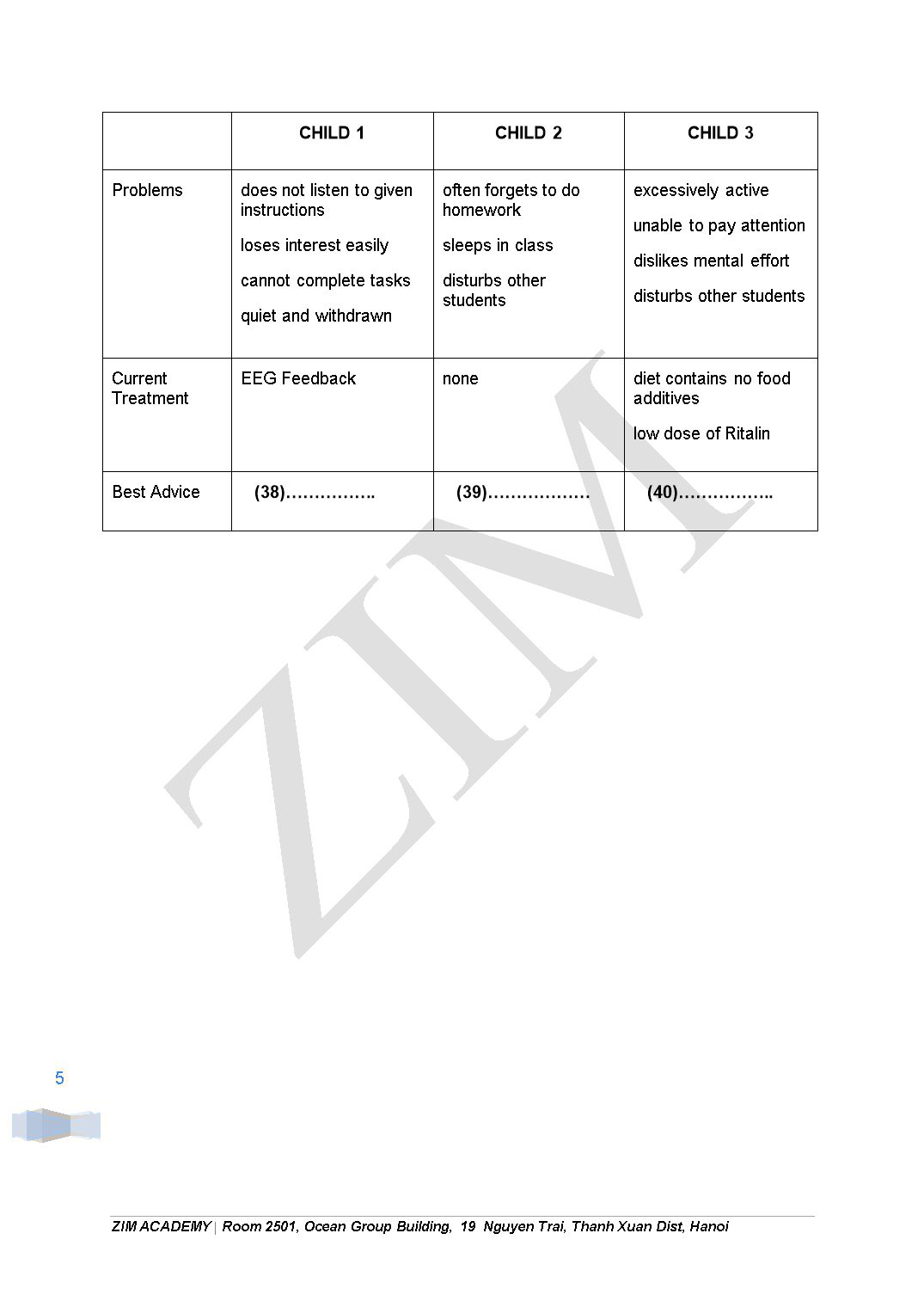
Trang 5
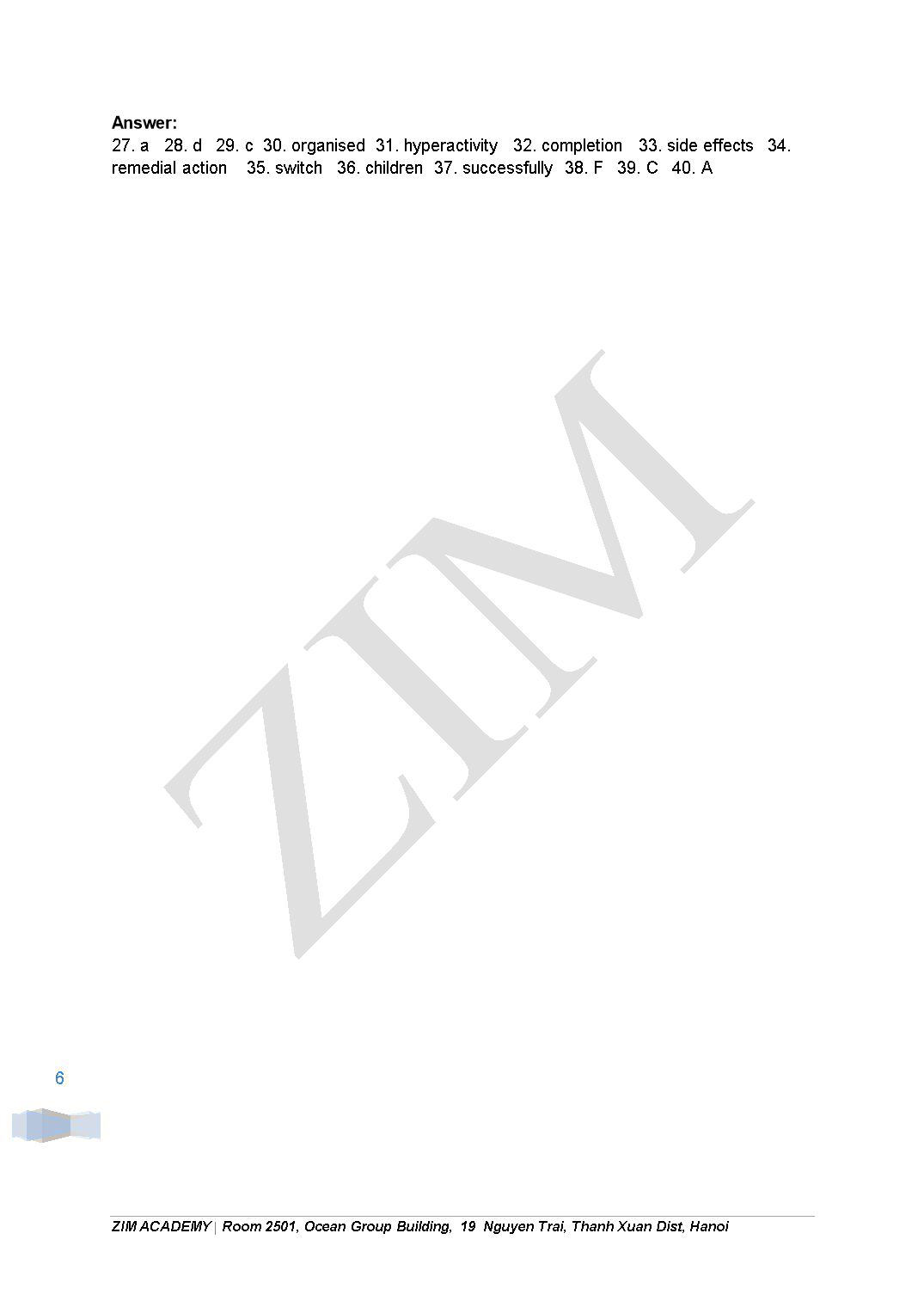
Trang 6
Tóm tắt nội dung tài liệu: Ielts academic Reading 13
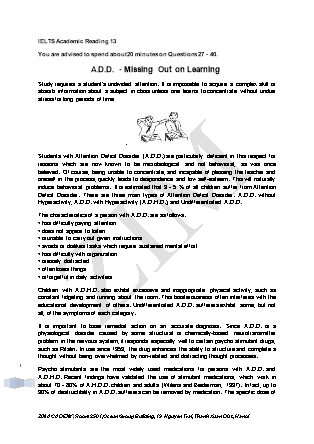
IELTS Academic Reading 13 You are advised to spend about 20 minutes on Questions 27 - 40. A.D.D. - Missing Out on Learning Study requires a student's undivided attention. It is impossible to acquire a complex skill or absorb information about a subject in class unless one learns to concentrate without undue stress for long periods of time . Students with Attention Deficit Disorder (A.D.D.) are particularly deficient in this respect for reasons which are now known to be microbiological and not behavioral, as was once believed. Of course, being unable to concentrate, and incapable of pleasing the teacher and oneself in the process, quickly leads to despondence and low self-esteem. This will naturally induce behavioral problems. It is estimated that 3 - 5 % of all children suffer from Attention Deficit Disorder. There are three main types of Attention Deficit Disorder: A.D.D. without Hyperactivity, A.D.D. with Hyperactivity (A.D.H.D.), and Undifferentiated A.D.D. The characteristics of a person with A.D.D. are as follows: • has difficulty paying attention • does not appear to listen • is unable to carry out given instructions • avoids or dislikes tasks which require sustained mental effort • has difficulty with organization • is easily distracted • often loses things • is forgetful in daily activities Children with A.D.H.D. also exhibit excessive and inappropriate physical activity, such as constant fidgeting and running about the room. This boisterousness often interferes with the educational development of others. Undifferentiated A.D.D. sufferers exhibit some, but not all, of the symptoms of each category. It is important to base remedial action on an accurate diagnosis. Since A.D.D. is a physiological disorder caused by some structural or chemically-based neurotransmitter problem in the nervous system, it responds especially well to certain psycho stimulant drugs, such as Ritalin. In use since 1953, the drug enhances the ability to structure and complete a thought without being overwhelmed by non-related and distracting thought processes. Psycho stimulants are the most widely used medications for persons with A.D.D. and A.D.H.D. Recent findings have validated the use of stimulant medications, which work in about 70 - 80% of A.H.D.D. children and adults (Wilens and Biederman, 1997). In fact, up to 90% of destructibility in A.D.D. sufferers can be removed by medication. The specific dose of medicine varies for each child, but such drugs are not without side effects, which include reduction in appetite, loss of weight, and problems with falling asleep. Not all students who are inattentive in class have Attention Deficit Disorder. Many are simply unwilling to commit themselves to the task at hand. Others might have a specific learning disability (S.L.D.). However, those with A.D.D. have difficulty performing in school not usually because they have trouble learning 1 , but because of poor organization, inattention, compulsion and impulsiveness. This is brought about by an incompletely understood phenomenon, in which the individual is, perhaps, best described as 'tuning out' for short to long periods of time. The effect is analogous to the switching of channels on a television set. The difference is that an A.D.D. sufferer is not 'in charge of the remote control'. The child with A.D.D. is unavailable to learn - something else has involuntarily captured his or her whole attention. It is commonly thought that A.D.D. only affects children, and that they grow out of the condition once they reach adolescence. It is now known that this is often not the case. Left undiagnosed or untreated, children with all forms of A.D.D. risk a lifetime of failure to relate effectively to others at home, school, college and at work. This brings significant emotional disturbances into play, and is very likely to negatively affect self-esteem. Fortunately, early identification of the problem, together with appropriate treatment, makes it possible for many victims to overcome the substantial obstacles that A.D.D. places in the way of successful learning. 1 approximately 15% of A.D.H.D. children do, however, have learning disabilities Alternative Treatments for A.D.D. Evaluation EEG Biofeedback Dietary intervention (removal of food additives -preservatives, colorings etc.) Sugar reduction (in A.D.H.D.) Correction of (supposed) inner-ear disturbance Correction of (supposed) yeast infection (Candida albicans) Vitamin/mineral regimen for (supposed) genetic abnormality Body manipulations for (supposed) misalignment of two bones in the skull expensive trials flawed - (sample groups small, no control groups) ineffective numerous studies disprove link slightly effective (but only for small percentage of children) undocumented, unscientific studies inconsistent with current theory lack of evidence inconsistent with current theory lack of evidence theory disproved in the 1970s lack of evidence inconsistent with current theory Figure 1. Evaluations of Controversial Treatments for A.D.D. Questions 27-29 You are advised to spend about 5 minutes on Questions 27-29. Refer to Reading Passage 13 "A.D.D. - Missing Out On Learning", and decide which of the answers best completes the following sentences. Write your answers in boxes 27 - 29 on your Answer Sheet. The first one has been done for you as an example. Example: The number of main types of A.D.D. is: a) 1 b) 2 c) 3 d) 4 Q. 27. Attention Deficit Disorder: a) is a cause of behavioural problems b) is very common in children c) has difficulty paying attention d) none of the above Q. 28. Wilens and Biederman have shown that: a) stimulant medications are useful b) psychostimulants do not always work c) hyperactive persons respond well to psychostimulants d) all of the above Q. 29. Children with A.D.D.: a) have a specific learning disability b) should not be given medication as a treatment c) may be slightly affected by sugar intake d) usually improve once they become teenagers Questions 30-37 You are advised to spend about 10 minutes on Questions 30 - 37. The following is a summary of Reading Passage 13. Complete each gap in the text by choosing 30 - 37 on your Answer Sheet. Write your answers in boxes. Note that there are more choices in the box than gaps. You will not need to use all the choices given, but you may use a word, or phrase more than once. Attention Deficit Disorder is a neurobiological problem that affects 3 - 5% of all .....(Ex:). ...... Symptoms include inattentiveness and having difficulty getting (30) , as well as easily becoming distracted. Sometimes, A.D.D. is accompanied by (31) In these cases, the sufferer exhibits excessive physical activity. Psychostimulant drugs can be given to A.D.D. sufferers to assist them with the (32) of desired thought processes, although they might cause (33) Current theory states that medication is the only (34) that has a sound scientific basis. This action should only be taken after an accurate diagnosis is made. Children with A.D.D. do not necessarily have trouble learning; their problem is that they involuntarily (35) their attention elsewhere. It is not only (36) that are affected by this condition. Failure to treat A.D.D. can lead to lifelong emotional and behavioral problems. Early diagnosis and treatment, however, are the key to (37) overcoming learning difficulties associated with A.D.D. side effects successfully completion adults medicine switch drug Ritalin hyperactivity organized losing weight A.D.H.D. children attention remedial action paying Questions 38 - 40 You are advised to spend about 5 minutes on Questions 38 - 40. Refer to Reading Passage 13, and decide which of the following pieces of advice is best suited for child listed in the table below. Write your answers in boxes 38 - 40 on your Answer Sheet. ADVICE: A current treatment ineffective - suggest increased dosage of Ritalin. B supplement diet with large amounts of vitamins and minerals. C probably not suffering from A.D.D. - suggest behavioral counseling. D bone manipulation to realign bones in the skull. E EEG Biofeedback to self-regulate the child's behavior. F daily dose of Ritalin in place of expensive unproven treatment. CHILD 1 CHILD 2 CHILD 3 Problems does not listen to given instructions loses interest easily cannot complete tasks quiet and withdrawn often forgets to do homework sleeps in class disturbs other students excessively active unable to pay attention dislikes mental effort disturbs other students Current Treatment EEG Feedback none diet contains no food additives low dose of Ritalin Best Advice (38). (39) (40).. Answer: 27. a 28. d 29. c 30. organised 31. hyperactivity 32. completion 33. side effects 34. remedial action 35. switch 36. children 37. successfully 38. F 39. C 40. A
File đính kèm:
 ielts_academic_reading_13.doc
ielts_academic_reading_13.doc

